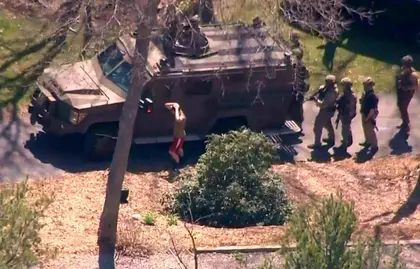FBI agents, many heavily armed, surrounded a house in rural Massachusetts yesterday, April 13, to take custody of 21-year-old Airman First Class Jack Teixeira. He will face charges of leaking US government documents full of highly classified information – including about the war in Ukraine.
Teixeira was a member of the Massachusetts Air National Guard and worked on an air base in Cape Cod, Massachusetts.
In Washington, Attorney General Merrick Garland, in a brief statement, announced the arrest and said Airman Teixeira would be arraigned at the Federal District Court in Massachusetts. Garland said he was arrested in connection with the “unauthorized removal, retention and transmission of classified national defense information,” a reference to the Espionage Act, which is used to prosecute the mishandling and theft of sensitive intelligence.
How did a junior enlisted airman get access to top-secret information?
The New York Times reports that US Air Force officials claim Teixeira was trained as a “Cyber Transport Systems Journeyman.” The service’s career website says cyber transport systems specialists are responsible for keeping the force’s communication network running.
The job requires that applicants complete what the military calls a single-scope background investigation, which is required before being granted a top-secret security clearance.
All the same, officials are still scratching their heads and asking the same question – How did he get access to such sensitive information?

US: What are Kamala Harris's Chances of Winning?
Even though clearance requirements were reformed after Edward Snowden leaked documents from the US National Security Agency in 2013, it seems the reforms were not enough.
Apparently, too many low-level employees still have too much access to highly classified information.
What will happen to the suspect?
He will certainly need to “lawyer up.”
Indeed, when Teixeira’s mother, standing in front of the home where her son lives, was asked by a New York Times reporter if Airman Teixeira was there and willing to speak, the airman’s stepfather, Thomas P. Dufault, said: “He needs to get an attorney if things are flowing the way they are going right now. The feds will be around soon, I’m sure.”
Once in custody the FBI will try to assess how many documents were leaked, which ones, when, and who else may have had access.
According to a Washington Post interview with one of the members, there were foreign nationals among the small group of about 20 who were privy to the initial disclosures. Some were believed to be from Eastern Europe, either Ukrainian or Russian.
The US authorities will certainly need to track down the other members of the group.
A person convicted in such a leak could face extended prison time, officials said. Airman Teixeira was arrested under the Espionage Act, violations of which carry a penalty of up to 10 years in prison per count.
Why did it take so long for people to become aware of the documents?
Much of the information, originally posted on Discord, a messaging platform popular with gamers, languished in obscurity there, visible to only about 20 members of the chat group, according to a member interviewed by the Washington Post, who did not reveal his name.
The first news outlet to offer an extensive genealogy of the documents’ manifestation in cyberspace was Bellingcat, an organization that specializes in digital forensics, which focuses on identifying, acquiring, processing, analyzing, and reporting on data stored electronically.
So, all the talk about this being an American psyops campaign to confuse the Russians was wrong?
It would seem so. If it were indeed an operation staged to confuse the Russians, then one would have to admire the sheer complexity of it.
There is still the remote possibility that some of the information was intentionally falsified by either the Americans, or, more likely, someone else further down the food chain.
In fact, one of the documents dealing with numbers of casualties on both sides appeared to have been manipulated to show that Ukrainians lost nearly five times more personnel than the Russians, which is frankly hard for anyone – not even Russian propagandists – to believe.
So, what does this mean for Ukraine?
Many of the revelations in the leaked documents concerned the ongoing war in Ukraine.
One document noted that nearly 100 NATO special forces are on the ground in Ukraine, training the Armed Forces of Ukraine (AFU).
Pentagon officials appeared to express a more pessimistic outlook on private channels than in public.
Of particular concern for the AFU was the Pentagon’s assessment of air defenses protecting sensitive sites, military personnel and equipment, and civilians.
The Washington Post reported that according to one of the documents, a late February assessment from the Defense Department’s Joint Staff, Ukraine’s “ability to provide medium range air defense to protect the [front lines] will be completely reduced by May 23. UKR assessed to withstand 2-3 more wave strikes.
“As first Layer Defense munitions run out, second and third layer expenditure rates will increase, reducing the ability to defend against Russian aerial attacks from all altitudes,” the classified document says.
Also, as a result of the leaks, Ukraine was reported to be adjusting its plans for the expected spring counteroffensive.
However, Ukrainian Defense Minister Oleksiy Reznikov denied this claim, noting that any true information in the files is no longer relevant.
You can also highlight the text and press Ctrl + Enter






